#oregon dunes national recreation area
Explore tagged Tumblr posts
Text
The Center for Biological Diversity warned the U.S. Forest Service today that it intends to sue the agency for failing to protect coastal martens from destructive off-road vehicles in the Oregon Dunes National Recreation Area. Coastal martens are protected as threatened under the Endangered Species Act.
“Thousands of off-road vehicles are roaring through the dunes, driving coastal martens to the brink, but the Forest Service is doing next to nothing to save them,” said Tala DiBenedetto, a carnivore conservation staff attorney at the Center. “The agency needs to act fast to protect these cute little carnivores in one of the last places they call home.”
In a single weekend, thousands of off-road vehicles can drive through and damage marten habitat in the Oregon Dunes National Recreation Area. Off-road vehicles create noise disturbances, destroy habitat and could run over or strike coastal martens. These risks increase during special riding events permitted by the Forest Service — like Coos Bay’s “UTV Takeover,” held annually in June.
Today’s notice says that the Forest Service must analyze and mitigate the risks to martens. This could include fencing to keep off-road vehicles in designated riding areas, enforcing existing decibel limits and limiting the number of off-road vehicles allowed in the National Recreation Area at a given time.
Fewer than 400 coastal martens remain in four highly isolated populations in Oregon and California. Approximately 71 of those individuals live in the Oregon Dunes National Recreation Area, which the Forest Service manages. Scientists warn that the fragile marten population in the Oregon Dunes could be wiped out if just two or three of the imperiled animals are killed by people in a single year.
“If the Forest Service doesn’t take immediate action to protect these vulnerable martens, they could disappear from the Oregon Dunes forever,” said DiBenedetto. “The agency has a duty to these martens and to the many Oregon Dunes visitors and community members who care about them.”
Today’s notice gives the Forest Service 60 days to correct its legal violations. If the agency fails to do so, the Center is prepared to file a lawsuit to protect coastal martens.
#enviromentalism#ecology#Coastal martens#mustelids#oregon#Oregon Dunes National Recreation Area#endangered species act#us forest service
1 note
·
View note
Text
Biggest galaxy brain moment from visiting the Dune dunes is that it gave me a whole new perspective on why the terraforming of Arrakis is treated with such deep ambivalence by the text. Because the terraforming process that's described in great detail in the book? That's exactly what's happening to the Oregon dunes. And they're disappearing.

At the beginning of the 20th century, the open sand you see in this picture stretched all the way to the Pacific Ocean, which is visible here as a faint blue-gray line about halfway up the photo. The sea washed new sand ashore, and the seasonal wind cycles blew it into a constantly-shifting landscape of dunes, tree islands, ghost forests and both permanent and ephemeral lakes and rivers.
As European colonization of the Pacific Northwest grew, the new settlers and the logging and commercial fishing industries they brought with them wanted permanent towns and roads that weren't constantly being swallowed by the moving sand. Starting in the 1930s, European beachgrass and other non-native species were introduced to try to hold the dunes in place.
The invasive species did hold the dunes in place--too well. The deep roots of the beachgrass shaped the sand blowing in off the beach into a permanent dune parallel to the ocean, called the foredune.

As the foredune got taller, it blocked both wind and the movement of sand, which allowed the land behind it to become grassland...

then forest.

Walking through this area, you might never know there was a dune under your feet. You can be close enough to hear the ocean, but there is almost NO wind--the main force that shapes the dunes.
There are (slow, difficult) remediation efforts underway to control the European beachgrass and restore at least some of the area to the natural dune cycle that created the miles and miles of open sand. But the ecological feedback loop created by introducing the beachgrass is stubborn, and without any further intervention, the dunes could be completely covered with forest in as little as a few decades. (I've heard estimates from 50 to 150 years, both of which are a blink of an eye in geological timescales.) The Oregon dunes are at least 100,000 years old, and within the span of just a few human lifetimes the ecosystem could be irrevocably changed.
The dune stabilization project is what Frank Herbert came to Florence to research for a never-written magazine article. Herbert began writing Dune in the mid-1950s, but by the mid-60s when the book was published, his own politics had shifted as he was influenced by the growing environmental movement and by Native activism happening around him in the Pacific Northwest. Like the story of the Oregon dunes, the terraforming of Arrakis is initially promoted as triumph of science and human rationality over nature that will make people's lives easier. But it ends up destroying the native ecosystem and the way of life of the planet's indigenous people, as becomes clear in Dune Messiah when Paul actually implements the terraforming project. (In the book, Dr. Kynes, the main architect of the terraforming project, dies in a spice blow--literally swallowed whole by the planet he tried to control.) It's one of the many political/ideological tensions in the story that's presented but not resolved, and I'm super curious to see how this element of the story is handled in Villeneuve's Dune Messiah.
All photos above taken by me at the Oregon Dunes National Recreation Area in September 2024.
138 notes
·
View notes
Text
Explore the Best Features of Oregon Coast Tours and Portland City Tour
Oregon has a remarkable combination of scenic beauty and urban energy. Combining an Oregon Coast trip with a Portland city tour allows you to experience the best of both worlds, whether you're a nature lover or a city enthusiast. Here's why your trip schedule should prioritize this dynamic combo. Oregon Coast tours let you discover the beautiful Oregon Coast, which stretches for more than 360 miles, is a magnificent location with some of the most gorgeous landscapes in the Pacific Northwest. There is plenty to enjoy for everyone, from picturesque coastal villages to breathtaking cliffs and immaculate beaches.
Tours along the Oregon Coast are an excellent opportunity to discover this varied terrain. Often, guided trips take you to famous locations like the Oregon Dunes National Recreation Area, where sand dunes stretch for miles, or Cannon Beach, which is home to the massive Haystack Rock. Tours might include things like trekking through coastal woods, whale viewing, or discovering tidal pools full with vibrant marine life, depending on your interests. Beautiful lighthouses like the Heceta Head Lighthouse and charming fishing villages like Newport and Astoria can be found along the coast. Here, you may savor fresh seafood and discover the nautical past of Oregon. An Oregon Coast trip allows you to fully experience the splendor of nature, whether you're searching for adventure or leisure.
Portland, a lively, eccentric city renowned for its culinary culture, craft beer, and distinctive neighborhoods, is only a short drive from the coast and provides an entirely different atmosphere. For individuals who are interested in exploring the city's culture further or are first-time visitors, a Portland city tour offers a carefully selected overview of the main sites in the area.
A typical trip takes you to famous locations including Powell's City of Books, the world's biggest independent bookshop, and Pioneer Courthouse Square, sometimes referred to as "Portland's Living Room." Legendary food carts can be found around the city, and a lot of tours that visit some of the top food trucks, coffee shops, and breweries in Portland showcase the city's culinary scene. You can also hire tour guide Multnomah Falls who helps you to discover the best features of the falls that can refresh and rejuvenate your mind. With all of these ingredients, it becomes easy to get the best glimpse of nature that can perfectly make your weekend.
0 notes
Text
Oregon Dunes
The western Sahara Desert has an average high temperatures of 120°F, annual rainfall of 4 inches, and sand dunes. Death Valley, California, has an average temperatures of 120°F, annual rainfall of 1.7 inches, and sand dunes. Florence, near the Oregon coast, has an average high temperature of 75°F, annual rainfall of more than 156 inches, and . . . sand dunes. Lots of sand dunes.
The Oregon Dunes National Recreation Area extends from Florence to Coos Bay, nearly forty miles along the Oregon coast. These constitute the longest stretch of coastal dunes in the United States. They prove that it is not temperature and rainfall that makes sand dunes; it is wind, sand, and time.
About six thousand years ago, the present Oregon coastline stabilized, more or less, as did most of the weather patterns we see today. For thousands of years winds blew sands from the beaches upward, five hundred feet above sea level, to rest on a sandstone rock formation, where the sand began to pile up. Once there, it was contained by the mountains east of and above the sandstone bedrock. Unlike many other sand dune formations, where the winds have been steady and generally from one direction, the Oregon dunes are as ever changing as the winds.
The summer winds along that portion of the coast are from the north and average 12-16 miles per hour in summer. The winter winds come from the south, with varying force, though they can reach 100 miles per hour during storms. The winds reshape the dunes from season to season. In addition to wind action, the heavy rainfall along the coast affects the dunes in many ways. There are several lakes within the dunes; some of them silt up, and others form when rainwater fills depressions in the dunes. In some places, there are marshes and quicksand.
That changing landscape is part of the reason why some people visit the dunes. The many tour companies lining the Coast Highway give guided tours of the dunes and rent various kinds of ATVs to tourists. Yet, every year, just as sure as the tourists come to see the dunes, the tour companies and the government save many tourists and their equipment from quicksand and other natural obstacles.
0 notes
Text






























World Sand Dune Day
Vital natural barriers, these landforms protect coastlines, support diverse habitats, and maintain ecological balance in our environment.
Sand dunes are natural landscapes that can be found wherever loose sand is blown, most typically in deserts or on beaches. They serve as a habitat for many interesting and rare species of animals and plants, as well as acting as a place of recreation for people from local communities or further afield. But due to activities by humans as well as erosion, sand dunes in some places may be under threat.
The hope of World Sand Dune Day is to draw attention to these amazing natural features and encourage individuals, families and communities to get involved in caring for them in a protective, restorative way.
History of World Sand Dune Day
World Sand Dune Day was started in 2021 as a collaboration between two organizations, Dynamic Dunescapes and Sands of LIFE, both projects which are working to protect and restore coastal sand dune systems in the UK. In Ireland, the day is celebrated and supported by the organization called Clean Coasts. Other communities and organizations dedicated to sand dunes also celebrate this day in places all throughout the globe.
This event was founded with the purpose of highlighting the importance of sand dunes for their various ways they serve the ecosystems. This includes biodiversity, acting as a home to many different species of plants and animals, as well as serving as a barrier from waves and surges. In addition, World Sand Dune Day also highlights the recreation that sand dunes provide for humans.
How to Celebrate World Sand Dune Day
Consider some of these ideas for how to get started with celebrating World Sand Dune Day:
Attend World Sand Dune Day Events in the UK
The different organizations that support World Sand Dune Day will host various events and activities at different sites. The schedule changes each year and is based on location, but some activities might include explorations, tours, crafts for kids, spider hunts, butterfly walks, bird walks, orchid walks, art workshops for adults and so much more! Check out the activities calendar at your local sand dune for more information, or find event listings by location at the Dynamic Dunescapes website.
Visit a Sand Dune Area in the US
An excellent way to celebrate World Sand Dune Day might be to head over to the closest national park or other sand dune and pay a visit. While there, be sure to follow all of the safety and conservation rules, and also don’t forget to clean up after yourself! Check out some of these popular sand dune destinations in the US:
Pacific City Sand Dunes in Oregon
Algodones Dunes and Imperial Sand Dunes in California
Jockey’s Ridge State Park Sand Dunes in North Carolina
Sleeping Bear Dunes National Park in Michigan
Support a Sand Dune Charity
Those who aren’t up for a visit to a sand dune park but would like to participate in the day can certainly make a difference by providing a donation to a worthy cause. Different charities have been started to protect the sand dunes in different states and countries around the world. Find out through an online search which one is local and then get connected!
Source
#Nares Mountain#Caribou Mountain#Carcross Desert#Yukon#travel#original photography#vacation#tourist attraction#landmark#landscape#summer 2023#nature#tree#countryside#Canada#the North#What are the hashtags?#ProtectOurDunes#WorldSandDuneDay#Last Saturday in June#29 June 2024#World Sand Dune Day#Sand Mountain#Nevada#Wadi Rum#Jordan#Miami Beach#Death Valley#Monument Valley#Arches National Park
1 note
·
View note
Text
Oregon Dunes National Recreation Area // gregorhofbauer

Ready to embark on an epic sandboarding adventure? Head to Oregon Dunes National Recreation Area and let the fun begin.
1 note
·
View note
Photo

Oregon Dunes National Recreation Area // gregorhofbauer Get lost in the sandy wonderland of Oregon Dunes National Recreation Area. Captured by gregorhofbauer
0 notes
Text
Oregon Dunes National Recreation Area // gregorhofbauer

Get lost in the sandy wonderland of Oregon Dunes National Recreation Area. Captured by gregorhofbauer
1 note
·
View note
Text
Enchanting Oregon Islands To Enjoy Unforgettable Adventures And Scenic Beauty

f you’re seeking an adventure-packed trip to Oregon, exploring the Oregon Islands is a must. While you’re here, you can visit the stunning Cannon Beach and walk along the shore to the iconic Haystack Rock, a magnificent sight to behold.
The secluded Cape Lookout State Park boasts great hiking trails and an enchanting beach to catch the perfect sunset.
Next, head to the Oregon Dunes National Recreation Area and embark on a thrilling dune buggy ride or horseback ride along the picturesque sand dunes.
0 notes
Text
Day 40
I left the sardine can of South Beach State Park and am due to leave Oregon today. I have picked most of my stops based on what I see on my upcoming route while looking at my National Geographic Adventure Atlas. If you like to road trip, travel, camp, the outdoors in general, I couldn’t suggest this atlas enough. I got one as a gift in 2007 and I have been a steadfast user ever since. So often there is no service when I’m traveling, and even if there is, it's hard to know where to start randomly googling to find what may interest me. It feels like a shot in the dark when there’s the world wide web out there and no point of reference to start at. Enter, the Nat Geo Adventure Atlas; it lists points of interest, scenic sights and drives, camps, parks, rest stops, weird stuff, some stuff that is intriguing because Google may not have a lot to say about it. I have found some amazing spots using this atlas and couldn’t suggest it enough. (*this post NOT sponsored by Nat Geo, although I kinda wish it was.)
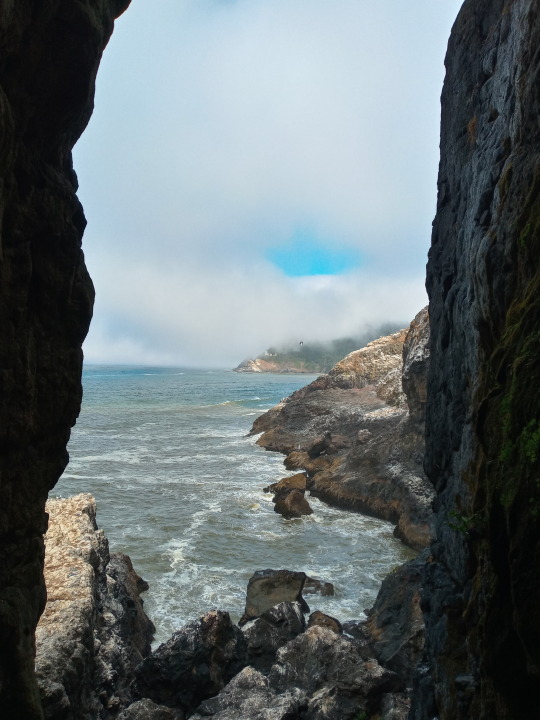
What did I see on the atlas this morning? Sea Lion Caves. Having no idea what it was, I headed out. It’s a privately run site that, contrary to what I’m used to in Texas, seems to be doing a pretty good job with conservation and protection of the land and the sea lions. I hadn’t realized I had seen shots of this famous cave so many times in my life, but surprise, there it is! This is the largest sea cave in the US and the sea lions congregate here in the winter. Being summer, they warned me there will be no sea lions in the cave, so they gave me a discount and a rain check to come back anytime in the future to try again. I’m ok with that, especially because just down the path towards the cave, I stopped to get a picture of a huge group of cormorants hanging out on a cliff face when, hey, lookie there, a bunch of sea lions. Everyone had just walked past them straight to the elevator, down to the cave that they know has no sea lions in it. They leave the cave in summer to their rookeries on the cliffs during summer in order to have their babies.
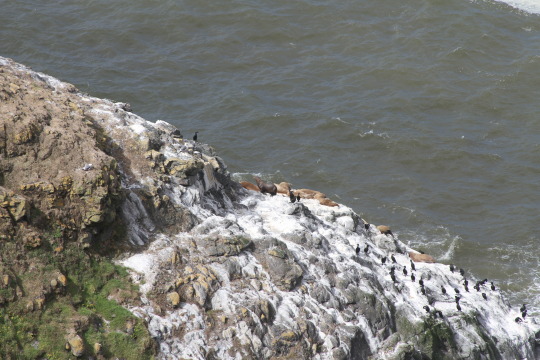
I actually heard them before I spotted them, so I must have rolled a 20 on my wildlife skills. I pointed them out to all the passerby’s, who were amazed, especially those who had just journeyed to the empty cave.
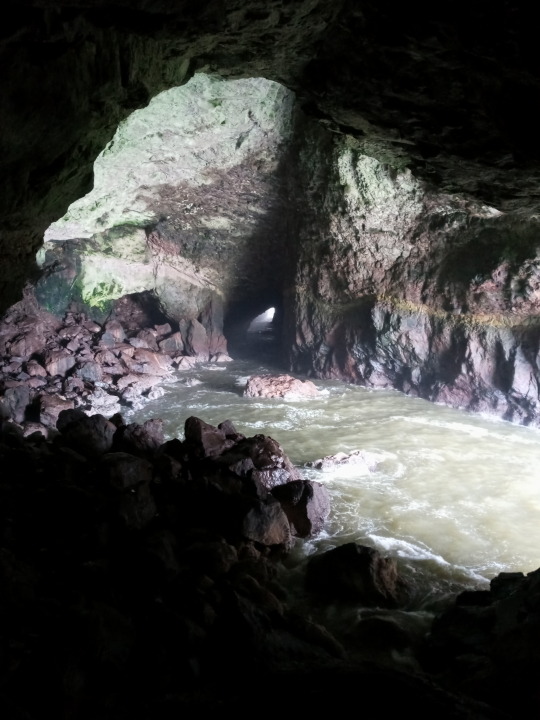
Down at sea level, they had plenty of exhibits in the cave, even telling you the sea lions are probably on the cliffs outside since it’s summer. The cave was pretty, and I can imagine how cool it would be if it were filled with sea lions, but I enjoyed the video and the view of the lighthouse.

Of course, I stopped on the way out to watch more sea lions (first time sea lion spotter here). I took the other hike to a coast view, where I spotted three lonesome sea lions hanging out just below the overlook. I got to see two of them jump into the water and jump up like a dolphin. All I can think of is that old cartoon I loved as a kid where the little baby seal follows Mickey Mouse home from the zoo and gets in the bathtub with him. What a great cartoon.

I had some lunch on the road and headed down to Oregon Dunes National Recreation Area, run by the Forest Service. I received the Oregon Dunes/Suislaw National Forest Junior Ranger Badge! I dedicate this badge to Bobbie and Bud. Thanks for supporting my fundraiser! It means the world to me to have family come to bat for something I not only care about, but I struggle with every day. I hope someday soon we can catch up at a gathering, it’s been so very long!

I headed to a short, paved hike through the forest that would lead me to the dunes. I wasn’t going to head all the way to the ‘actual’ beach, as I am definitely not feeling up to a 2-mile hike, one-way, over sand dunes. I was happy enough reaching the edge of these goliaths, slipping out of my flip flops, and roaming up the nearest hill like Lawrence of Oregonia.

I just sat up there a while, watching the wind blow an almost invisible layer of sand into the atmosphere. Even though this is a common entry point, once I was on top of the dune, the other side was pristine; no footprints, no sled marks.
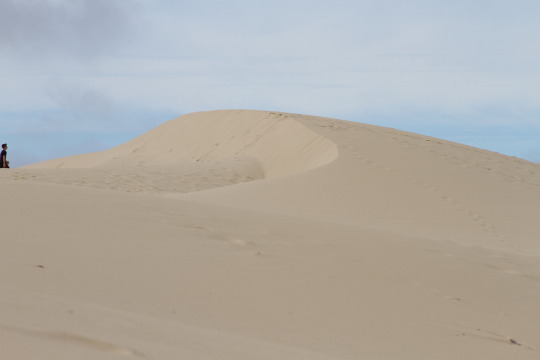
I love driving the Northwest coast, the same as I love just sitting on their beaches; the clouds though the Earth in a way that makes it look like the land just slips away into the sky and nothing lays beyond. The shroud of fog that, once you go through it, could be the portal to another world. It’s just so magical, watching the trees disappear into the mist, the horizon held hostage by white. The smudge of atmosphere that steals definition of land, sea, and sky.
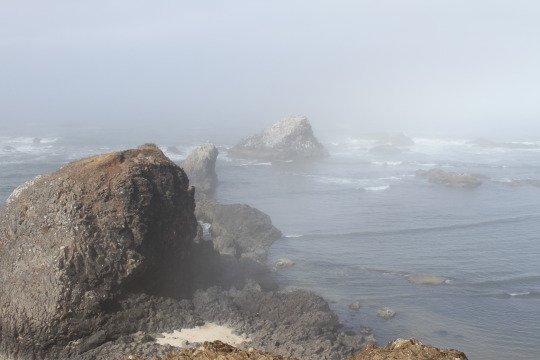
I arrived at the KOA Redwoods, which I’ve stayed at before. It’s by no means the nicest KOA, but it’s the prettiest one I’ve seen, as much of it is set back in a thick forest of (you’ll never guess) Redwoods and ferns. This time I booked a pull through site, guessing I would be tired, so I didn’t think I’d end up in the pretty forest. When I checked in, the clerk said they were refunding me $1.25, but didn’t know why. Odd…but ok..? I looked at the map and the spot wasn’t a pull through and was back in the hard to navigate maze of trees so I asked if the refund was because they took away the pull through site I booked. She looked kind of scared and said, “I guess so.” I don’t require much, but a little, “Oh yes, sorry about that.” Would have sufficed. I do get peeved when a company/employee can’t say “whoops, sorry about that” even if I know they can’t fix it (I’m looking at you, Halloweentown.)
I may have lost my pull-thru site, but at least I was tucked back in the redwoods. It did, however, take me 3 passes, even using a map, to find the road going into the forest that my site was down. But boy howdy, I got $1.25.
Haylan
#oregon coast#sea lion caves#sea lions#road trip#road trip for a cause#ehlers danlos awareness#redwoods#oregon dunes#national recareation area#oregon dunes national recreation area#suislaw national forest#junior ranger#boy howdy
0 notes
Text

Boundless
Oregon Dunes National Recreation Area - John Dellenbeck Trail
#photographers on tumblr#original photographers#landscape#sand dunes#oregon#oregon dunes#peaceful#tranquility#scenic#scenery#landscape photography
14 notes
·
View notes
Text
Less than 400 Humboldt martens survive, with a special population living in dunes on the shore of the Pacific:


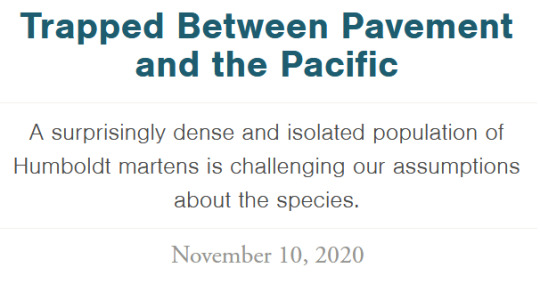
Most Pacific martens live in the mountains, but Humboldt martens -- a rare subspecies -- make their home along the coast. They once ranged from Northern California to the Oregon-Washington border, filling the ancient, towering forests that fringed the Pacific shore. Now, they’ve all but disappeared, and recently gained formal protection under the US Endangered Species Act. To everyone’s surprise, however, scientists discovered one of the few remaining populations here, on a strip of overgrown sand dunes 75 kilometers long and half a kilometer wide. This stand of moss-cloaked shore pine and punishing shrubs in the Oregon Dunes National Recreation Area [...] looks nothing like the majestic old-growth forests of yore. But the martens don’t seem to mind.
Indeed, this is the densest population anywhere on Earth. It’s also one of the most imperiled. The martens face threats from cars, development, and worst of all, isolation. More than 100 kilometers of fragmented forests and roads separates them from their nearest neighbors [...]. For decades, scientists feared that Humboldt martens had gone extinct. Then, in 1996, researchers spotted telltale prints on a track plate left in the woods of Northern California. In the years following, they found more signs of the animals. [...]
They constantly patrol the borders of their home range, traveling an average of six kilometers a day. “You have an animal that’s the size of a kitten,” Moriarty says. Yet “they are moving almost as much or more than a mountain lion on a daily basis.” [...]
By the time the naturalist Joseph Grinnell identified Humboldt martens as a distinct subspecies in 1926, demand for their luxurious pelts had already made the animals scarce. California banned trapping of coastal martens in 1946, but then came industrial logging. Timber companies harvested the biggest, oldest trees in which martens made their dens. And clearcuts left little protective cover on the landscape. Today, Humboldt martens occupy just seven percent of their historical range. [...]
Scientists now know of only four populations, each estimated to contain fewer than 100 adults. One resides just east of Redwood National and State Parks in Northern California. One straddles the California-Oregon border, and another hugs the southern Oregon coast near the Rogue River. In these three, most marten sightings have occurred in large patches of old-growth forest. [...]
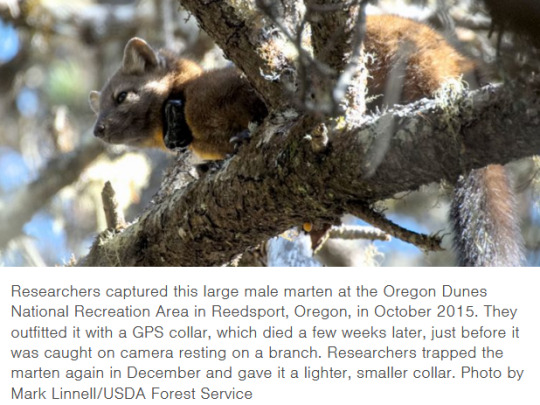

[T]he dune martens haven’t always fit in. Their existence challenged the long-held belief that martens primarily live in old-growth forests of redwood or Douglas fir. The short, gnarled trees here are no bigger than a fir branch, and the forest itself is young and somewhat artificial. Rolling dunes used to cover the area, but in the early 1900s, government agencies and private landowners planted beach grass to stop sand from blowing onto coastal roads. The grass stabilized the ground enough for shrubs to root, including invasive Scotch broom. Trees eventually followed, and by the middle of the century, a scrubby forest had sprouted. [...]
Research by Moriarty and her team has revealed that the shore pine forest makes a good home for martens because of its dense understory and abundant food. In fact, the 70-odd martens here have the smallest home range of any in the world. [...]
She’s come to suspect that the martens’ presence in this strange environment is actually a window into their past. Similar stands may have grown along flat, sandy stretches of the Oregon coast before towns and housing developments replaced them. And martens likely used that habitat until it vanished. [...] The paradox of the dune martens is that, despite their high density, the population also teeters on the verge of annihilation. The dunes actually host two groups of martens, separated by the Umpqua River, and each has barely enough adults to remain viable. For both, losing just two to three adults per year could send the population spiraling toward extinction, according to a 2018 study [...].
And new threats continue to arise. A Canadian pipeline company hopes to build a liquified natural gas terminal on private land at the southern end of the dunes. The Jordan Cove Project recently gained a key federal approval [...].
-------
Headlines, images, captions, and all text published by: Julia Rosen. “Trapped between pavement and the Pacific.” Hakai Magazine. 10 November 2020.
-------

The bushy-tailed carnivores were once common, but now fewer than 100 of them survive in California, while an unknown but very small number are still found in Oregon. A slender mustelid related to minks and otters, the coastal marten survives only in three isolated populations in old-growth forest and dense coastal shrub in Northern California and southern and central coastal Oregon. The marten faces a barrage of threats, including logging, fire, climate change, trapping in Oregon, vehicle strikes, rodenticide poisoning and small population size. [...] The coastal martens’ historic range extended from Sonoma County in coastal California north through the coastal mountains of Oregon; in Oregon the marten now lives only in a small area within Siskiyou and Siuslaw national forests. Coastal martens were believed extinct in California -- with 95 percent of their old-growth forest habitat lost and a history of excessive trapping -- until they were rediscovered on the Six Rivers National Forest in 1996. In 2009, the first California marten to be photographed in recent times was detected in Prairie Creek Redwoods State Park by remote-sensing camera. [Text excerpt from: “Saving the coastal marten.” Earth Justice.]
Historical distribution of American marten (in blue) and Pacific marten (in red-ish). Within the contiguous US, both species of marten have been eliminated from much of this historical distribution. The Humboldt marten is a subspecies/sub-population of the Pacific marten.
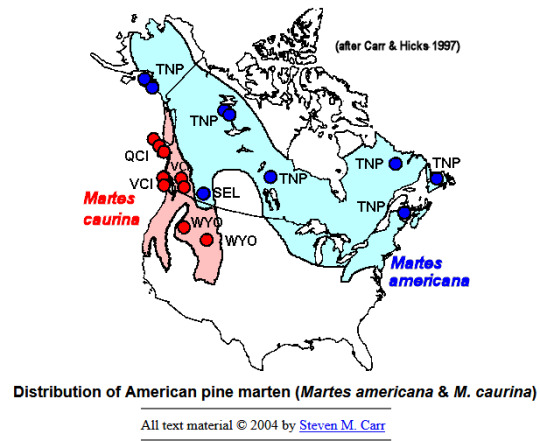


82 notes
·
View notes
Text
Things to Explore with Oregon Coast Tours and Portland City Tour
Travelers looking for a varied experience will find the state of Oregon to be the ideal location due to its alluring combination of urban sophistication and natural beauty. The Portland city tour and Oregon Coast tours are two of this lovely region's best attractions. Every one of them presents a different angle on the allure of Oregon—from the untamed coastline to the energetic urban. The Oregon Coast is a stunning 360-mile stretch of sand beaches, spectacular cliffs, and charming seaside towns. Oregon Coast excursions are a fantastic way to discover this picturesque paradise, giving visitors a chance to take in the region's varied scenery and extensive history.
The famous Highway 101, which winds down the coast and offers breathtaking views of the Pacific Ocean, is one of the highlights of these tours. Frequently visited locations include the well-known Cannon Beach, renowned for its imposing Haystack Rock, and the quaint town of Newport, which is home to the active Oregon Coast Aquarium and the historic Yaquina Head Lighthouse. Along with taking in the area's natural splendor, these tours include activities like trekking through verdant coastal forests, whale viewing, and tidal pool exploration. Another well-liked location is the Oregon Dunes National Recreation Area, where tourists may take in the striking scenery of towering sand dunes.
The Portland city tour provides an in-depth look at the bustling metropolitan life of Oregon's largest metropolis, in stark contrast to the scenic beauty of the coast. Portland, well-known for its diverse culinary scene, progressive culture, and verdant surroundings, is a city that skillfully combines modernism and a laid-back attitude.
Visiting famous sites like Powell's City of Books, the biggest independent bookshop in the world, and the International Rose Test Garden, which features thousands of rose species blooming against the backdrop of the city skyline, are all part of a typical Portland city trip. Another location that's a must-see is the Pearl District, which has boutiques, art galleries, and hip restaurants.
The tour's gastronomic component, which frequently includes stops at some of Portland's well-known food carts, breweries, and farm-to-table restaurants, will delight foodies. The city's inventive and varied culinary options demonstrate its dedication to sustainability and regional agriculture. If you want to experience nature then never skip any chance to hire tour guide Multnomah Falls who will assist you to explore the best features of this outstanding falls.
0 notes
Text
Weird Science on the Oregon Coast
Beachconnection.net, an Oregon coast tourism Web site, offers a look at several oddities along the shore. Among out favorites are the following items with a scientific bent.
Ghost Forests
Proposal Rock is a forest-topped sea stack in the tiny beach-front community of Nesktowin (fifteen miles north of Lincoln City). The basalt giant, a n undisturbed natural haven for sea birds, serves equally well as backdrop for an adjacent natural attraction. Appearing on the beach only during minus tides are the remains of an ancient forest, two thousand to five thousand years old. The sitka spruce trees, which stood majestically so many cons ago, are reduced to rocklike stumps, choked with seaweed and barnacles.
Another similar ghost forest can be found in Arch Cape, on the northern Oregon coast. Geologists have carbon dated these particular stumps to about four thousand years. Along with sitka spruce there are the remains of cedar and perhaps redwood trees.
Geologists have developed a sound theory on how the ghost forests came to be. They surmise that about four thousand years ago, coastal sand rose so rapidly that trees were buried and protected from conditions that would normally cause decay. Geologic shifting may have also dropped the forests about two dozen feet. Their reappearance in recent years has worried a few locals, as it may indicate increasing land erosion.
Singing Sand
Then there's the strange cacophony of "singing" sand. Sands in Oregon Dunes National Recreation Area (see the Ancient Mysteries chapter) and near Cannon Beach can make a singing or violinlike noise when stepped on or otherwise rubbed together.
The squeaking sound happens on some stretches of sand that have recently dried, mostly within one hundred feet or so from the shore. Grain size, density, shape, and other factors contribute to the particular tone of the "singing."
Remember, kids: Just because it's weird doesn't mean it can't be educational!
The Green Flash
The "green flash" at sunset along the coast is a relatively frequent event. According to Beachconnection.net, "The green flash is defined as a small, greenish blob you see just above the setting sun, just a second or so before it dips away below the horizon. Certain conditions must exist for you to see it, mainly that it is clear, with no clouds or fog, between you and the horizon." The flash is essentially an airborne mirage caused by the refraction of light from the sun at the horizon through layers of moist air. Because green and blue light are at the tail end of the visible spectrum of setting sunlight.
0 notes
Photo










Oregon was admitted as the 33rd U.S. state on February 14, 1859.
#Oregon#33rd US state#14 February 1859#anniversary#US history#USA#Baker Beach#Oregon Dunes National Recreation Area#Pacific Ocean#travel#landscape#summer 2017#Cannon Beach#Haystack Rock#Bandon#West Coast#Myers Creek Beach#Arch Rock#Sisters Rocks#Columbia River Gorge#Deadman Pass#Bridal Veil Falls#Portland#Jackson Tower#architecture#cityscape
31 notes
·
View notes
Photo

Oregon Dunes National Recreation Area
https://www.fs.usda.gov/recarea/siuslaw/recarea/?recid=42465
2 notes
·
View notes